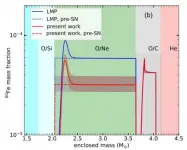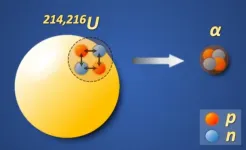(Press-News.org) Reston, VA--New research shows that a novel positron emission tomography (PET) tracer that targets inflammation is safe and can clearly identify early stages of rheumatoid arthritis. The promising PET tracer, 68Ga-DOTA-Siglec-9, rapidly clears from blood circulation, has a low radiation dose, and can be easily produced. This first-in-human study was published in the April issue of the Journal of Nuclear Medicine.
Inflammation is a significant part of several chronic diseases, including rheumatoid arthritis and its related issues. While PET imaging with 18F-FDG is a valuable tool for the diagnosis and monitoring of the effects of treatments, it is not specific enough to assess inflammation.
"It's important to detect inflammation early so that patients can receive the best treatment," said Anne Roivainen, PhD, professor of preclinical imaging and drug research at Turku PET Centre at the University of Turku and Turku University Hospital in Finland. "Our institution has worked for several years to develop an imaging agent that targets areas of inflammation, and in this study, tested its effectiveness in humans for the first time."
To evaluate the radiotracer's safety and biodistribution characteristics, six healthy study participants underwent whole body 68Ga-DOTA-Siglec-9 PET/computed tomography scans. 68Ga-DOTA-Siglec-9 was well-tolerated and cleared quickly from the blood, and its radiation dose was similar to other 68Ga tracers. In one additional study participant with rheumatoid arthritis, the tracer was able to clearly detect joints with arthritis.
"We have proven that the characteristics of 68Ga-DOTA-Siglec-9 are favorable for use in patient imaging studies," remarked Roivainen. "Future studies will clarify whether 68Ga-DOTA-Siglec-9 PET imaging has the potential to detect other inflammatory diseases early. It could also help to evaluate the effectiveness of treatments and promptly identify patients who are unlikely respond to therapy."
This study was made available online in August 2020 ahead of final publication in print in April 2021.
INFORMATION:
The authors of "First-in-Humans Study of 68Ga-DOTA-Siglec-9, a PET Ligand Targeting Vascular Adhesion Protein 1" include Riikka Viitanen, Olli Moisio, Xiang-Guo Li, Vesa Oikonen and Helena Virtanen, Turku PET Centre, University of Turku, Turku, Finland; Petteri Lankinen, Department of Orthopaedics and Traumatology, Turku University Hospital and University of Turku, Turku, Finland, and Turku PET Centre, Turku University Hospital, Turku, Finland; Mikko Koivumäki, Turku PET Centre, Turku University Hospital, Turku, Finland; Sami Suilamo, Department of Medical Physics, Turku University Hospital, Turku, Finland, and Department of Oncology and Radiotherapy, Turku University Hospital, Turku, Finland; Tula Tolvanen, Turku PET Centre, Turku University Hospital, Turku, Finland, and Department of Medical Physics, Turku University Hospital, Turku, Finland; Kirsi Taimen, Markku Mali, Ilpo Koskivirta and Laura Pirilä, Department of Rheumatology and Clinical Immunology, Division of Medicine, Turku University Hospital, Turku, Finland; Ia Kohonen, Department of Radiology, Turku University Hospital, Turku, Finland; Kristiina Santalahti and Sirpa Jalkanen, MediCity Research Laboratory, University of Turku, Turku, Finland; Anu Autio, Turku PET Centre, University of Turku, Turku, Finland, and MediCity Research Laboratory, University of Turku, Turku, Finland; Antti Saraste, Turku PET Centre, University of Turku, Turku, Finland, Turku PET Centre, Turku University Hospital, Turku, Finland, and Heart Center, Turku University Hospital, Turku, Finland; Pirjo Nuutila, Juhani Knuuti and Anne Roivainen, Turku PET Centre, University of Turku, Turku, Finland, and Turku PET Centre, Turku University Hospital, Turku, Finland.
Visit JNM's new website for the latest research in nuclear medicine and molecular imaging. To schedule an interview with the researchers, please contact Rebecca Maxey at (703) 652-6772 or rmaxey@snmmi.org
About JNM and the Society of Nuclear Medicine and Molecular Imaging
The Journal of Nuclear Medicine (JNM) is the world's leading nuclear medicine, molecular imaging and theranostics journal, accessed more than 11 million times each year by practitioners around the globe, providing them with the information they need to advance this rapidly expanding field. Current and past issues of the Journal of Nuclear Medicine can be found online at http://jnm.snmjournals.org.
JNM is published by the Society of Nuclear Medicine and Molecular Imaging (SNMMI), an international scientific and medical organization dedicated to advancing nuclear medicine and molecular imaging--precision medicine that allows diagnosis and treatment to be tailored to individual patients in order to achieve the best possible outcomes. For more information, visit http://www.snmmi.org.
New UCLA research suggests that elderly patients of female physicians are more likely than those of male physicians in the same outpatient practice to be vaccinated against the flu.
This trend holds for all racial and ethnic groups studied and could provide insight into improving vaccination rates for influenza, COVID-19 and other illnesses, according to the research letter, which is published in the peer-reviewed JAMA Internal Medicine.
Prior studies have shown that female physicians tend to spend more time with their patients, said study author Dr. Dan Ly, an assistant professor in the division of general internal medicine and health services research at the David ...
A single footprint left by a cat-sized dinosaur around 100 million years ago has been discovered in China by an international team of palaeontologists.
University of Queensland researcher Dr Anthony Romilio was part of the team that investigated the track, originally found by Associate Professor Lida Xing from the China University of Geosciences (Beijing).
"This footprint was made by a herbivorous, armoured dinosaur known broadly as a stegosaur - the family of dinosaurs that includes the famed stegosaurus," Dr Romilio said.
"Like the stegosaurus, this little dinosaur probably had spikes on its tail and ...
While Black, Hispanic, Latino, Indigenous, Asian and Pacific Islander people are more likely to die of COVID-19 than white people nationwide, a recent study from Oregon State University found the risk was even greater for racial and ethnic minority groups living in rural areas compared with urban areas.
To address the disparities, researchers say the health care response to COVID-19, including the vaccine rollout, needs to allocate additional resources to rural areas that have been hardest hit, especially those where minority populations are concentrated.
Earlier studies throughout the U.S. have shown that ...
EUGENE, Ore. -- April 16, 2021 -- University of Oregon physicists have developed a new method to manipulate sound -- stop it, reverse it, store it and even use it later -- in synthetic composite structures known as metamaterials.
The discovery was made using theoretical and computational analysis of the mechanical vibrations of thin elastic plates, which serve as the building blocks for the proposed design. The physicists, Pragalv Karki and Jayson Paulose, also developed a simpler minimal model consisting of springs and masses demonstrating the same signal manipulation ability.
"There have been a lot of mechanisms that can guide or block the transmission of sound waves through a metamaterial, but our design is the first to dynamically stop and reverse a sound pulse," said Karki, ...
NEW YORK, NY (April 16, 2021)--SARS-CoV-2, the virus that causes COVID-19, likely does not directly infect the brain but can still inflict significant neurological damage, according to a new study from neuropathologists, neurologists, and neuroradiologists at Columbia University Vagelos College of Physicians and Surgeons.
"There's been considerable debate about whether this virus infects the brain, but we were unable to find any signs of virus inside brain cells of more than 40 COVID-19 patients," says James E. Goldman, MD, PhD, professor of pathology & cell biology (in psychiatry), who led the ...
Understanding the components that control cell division is fundamental to understanding how life works and how alterations in this delicate process can cause diseases such as cancer. It was precisely the discoveries of "key regulators of the cell cycle" and their implications for processes such as cancer, that won the British scientists R. Timothy Hunt and Paul M. Nurse and the American scientist Leland H. Hartwell the 2001 Nobel Prize in Physiology or Medicine. A study led by Óscar Fernández-Capetillo, Head of the Genomic Instability Group at the Spanish National Cancer Research Centre (CNIO) and published this week in The EMBO Journal uncovers a new cell cycle control element, the USP7 protein. It acts as a brake to prevent cells ...
Researchers from the Institute of Modern Physics (IMP) of the Chinese Academy of Sciences and their collaborators have recently made great progress in the study of the stellar beta-decay rate of 59Fe, which constitutes an important step towards understanding 60Fe nucleosynthesis in massive stars. The results were published in Physical Review Letters on April 12.
Radioactive nuclide 60Fe plays an essential role in nuclear astrophysical studies. It is synthesized in massive stars by successive neutron captures on a stable nucleus of 58Fe and, during the late stages of stellar evolution, ejected into space via a core-collapse supernova.
The characteristic gamma lines associated with the decay of 60Fe have been detected by space gamma-ray detectors. By comparing the 60Fe ...
The first photosynthetic oxygen-producing organisms on Earth were cyanobacteria. Their evolution dramatically changed the Earth allowing oxygen to accumulate into the atmosphere for the first time and further allowing the evolution of oxygen-utilizing organisms including eukaryotes. Eukaryotes include animals, but also algae, a broad group of photosynthetic oxygen-producing organisms that now dominate photosynthesis in the modern oceans. When, however, did algae begin to occupy marine ecosystems and compete with cyanobacteria as important phototrophic organisms?
In a new study Zhang et al use the molecular remains of ancient algae (so-called biomarkers) to show that algae occupied an important ...
It is always exciting to find new isotopes with extreme neutron/proton numbers in nuclear physics research. In the region of heavy nuclei, α-decay is one of the pervasive decay modes and plays an essential role in searching for new isotopes. However, even after about a century of studying α-decay, scientists still cannot perfectly describe how the α-particle is formed at the surface of the nucleus before its emission.
In the α-decay process, the α-particle can be regarded not only as two protons plus two neutrons, but also as two proton-neutron pairs. Although previous studies have proved the importance of the pairing forces between the identical nucleons, it remains unclear whether ...
Older adults are more willing to make an effort to help others than younger adults, according to new research from the University of Birmingham.
The study, led by researchers in the University's School of Psychology, is the first to show how effortful 'prosocial' behaviour - intended to benefit others - changes as people get older. In particular, it focused on people's willingness to exert physical effort, rather than to give money or time, since attitudes to both these are known to change with age. The research results are published in Psychological Science.
In the study, the research team tested a group of 95 adults aged between 18 and 36, and a group of 92 adults aged 55-85. Each participant made 150 choices about whether or not to grip a handheld ...





